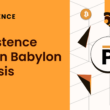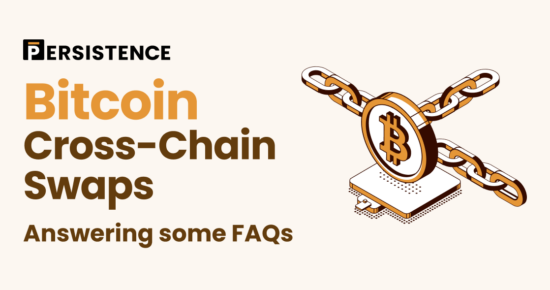Persistence is on a mission to provide a cohesive interoperability solution for BTC derivatives that will be powered by Cross-chain Intents.
With the testnet on the way, we decided to sit down and answer the most frequently asked questions in one location.
Let’s get into it!
What is BTCfi?
BTCfi refers to the Decentralized Finance (DeFi) industry within the Bitcoin ecosystem. This emerging industry intends to increase scalability and programmability on the Bitcoin network and introduce DeFi capabilities to BTC holders.
By introducing programmability, the BTCfi world is bringing DeFi applications such as yield farming, yield aggregators, lending, liquid staking, liquidity farming, DEXes, and DEX aggregators, allowing BTC holders to hunt for yield and do so much more with their BTC.
The concept excites Bitcoin aficionados as it holds the potential to transform Bitcoin’s value proposition from a simple store of value to a true yield-generating asset.
Why is interoperability important for BTCfi?
Over the last year, the number of BTC variants and derivatives has multiplied as the BTCfi industry continues to expand. However, these BTC variants are still unable to interact with each other, which leads to fragmentation, in turn hurting scalability. Interoperability is the solution.
Interoperability is important as it helps to onboard users by seamlessly connecting them across different blockchain ecosystems, enhancing the user experience and creating a powerful flywheel effect. Interoperability also boosts DeFi activity on BTC by providing an easier way to move Bitcoin around between chains as users hunt for the best returns on their BTC variants.
What are L2s?
Bitcoin Layer 2s are solutions built on top of the Bitcoin blockchain that seek to provide enhanced scalability or composability to the network on a separate layer.
These L2 are built on top of the Bitcoin blockchain.
As independent blockchains running a separate execution layer, L2s can introduce new features to the Bitcoin network through enhanced scalability and composability. For example, L2s can introduce unique features, such as smart contracts, to the Bitcoin network.
Typically, L2s compute transactions and then submit the details to the main layer for consensus. L2s can also use BTC as the gas token and leverage the Bitcoin blockchain for settlement, inheriting the enormous security model from the Bitcoin blockchain.
What are the differences between Bitcoin L2s and Sidechains?
A Sidechain is a blockchain that runs parallel to the native Bitcoin blockchain. They can use their consensus mechanism, which has the potential to be fine-tuned for speed or scalability.
Sidechains typically have a bridge to connect to the main blockchain, but they don’t usually support BTC, the native asset, and utilise their token for gas transactions.
Like L2s, Sidechains can add features to enhance scalability and programmability. However, the main difference is that Sidechains do not inherit the Bitcoin security model or utilize the BTC token for gas. Find out more about Bitcoin L2s vs Sidechains in this blog post.
What are Cross-Chain Intents?
A cross-chain intent is a mechanism that allows a user to specify the “what” of a particular swap without expressing the “how” it is achieved. They’re basically on-chain expressions of a user’s desired action and can be executed by anyone in any arbitrary way. It allows users to simply broadcast the “intent” to make a cross-chain swap while letting experts (referred to as Solvers) use their deep liquidity sources to execute the swap. These Solvers play a crucial role in the process, as they are responsible for executing the swap in the most efficient and cost-effective way.
To illustrate this, imagine a user wants to swap mBTC for sBTC on-chain. Traditionally, they would need to first unwind mBTC into BTC, then swap BTC for sBTC using a specific route. In an intent-based swap, however, the user simply broadcasts their intent to swap mBTC for a minimum amount of sBTC. A third-party solver is responsible for figuring out the route, which may involve unwinding mBTC into BTC and then swapping it for sBTC, all for a fee. However, the user doesn’t need to specify the process and can let a solver decide the best route for the swap.
Traditional bridges vs. intent-based swaps?
Traditional bridges allow users to transfer assets between different blockchain networks, helping enhance interoperability between chains. Essentially, they allow two separate blockchains to interact by creating a bridge between the networks.
Multiple mechanisms facilitate the function of a bridge. However, they traditionally require users to deposit the assets to be locked into a smart contract or centralized entity, with the representative assets being minted on the other side of the bridge.
In addition, traditional bridges are limited by TVL, presenting hurdles for scalability. They also have a poor user experience as they often require high gas fees with slow finality. Furthermore, traditional bridges can also experience slippage during the transaction and experience MEV.
While bridges have been integral to the growth of DeFi, they still pose major security risks for users. For example, numerous cases of bridge hacks have occurred over the years, losing millions in user funds. These hacks have raised serious concerns about the security of traditional bridges, highlighting the need for safer alternatives like intent-based swaps.
On the other hand, intent-based swaps provide a similar route to interoperability without requiring the trust of a third-party centralized entity. They provide access to global liquidity, experience zero slippage, are extremely fast, and require zero TVL.
Liquidity pools vs Intent-Based Swaps?
Liquidity pools for AMMs form the basis of DeFi trading. They allow buyers and sellers to easily swap assets in the pool for trading. They solved the problem of low liquidity by enabling users to deposit their assets to facilitate trades and earn fees.
While liquidity pools have caused immense growth in the DeFi space, they still limit swaps as they’re dependent on the liquidity in the pool. In addition, if there is a shortage of liquidity available, there’s a strong potential for slippage to occur, leading to unfavorable prices during the swap. Finally, liquidity pools also require incentives to bootstrap liquidity.
Although liquidity pools have pushed the boundaries of what’s possible in DeFi, intent-based swaps are emerging as a better contender for closely related assets like BTC derivatives. Intent-based swaps provide a better UX, faster swaps, and zero slippage. They also remove the potential for honeypots that have plagued the liquidity pool sector and AMMs.
What are the advantages of Intent-based swaps?
Intent-based swaps provide multiple advantages compared with other swapping options, including:
- More user friendly
- No slippage
- Zero-TVL required
- No need to incentivize liquidity
- More opportunities
- Interoperability
How Do Intent-Based Swaps Enhance Bitcoin Interoperability?
While AMMs have pushed the DeFi world to where it is today, they’re not well suited for closely related assets due to their lack of capital efficiency. As BTC variants are derivatives that are closely related in price, using an AMM would not be the ideal option for the majority of users.
In addition, liquidity pools in AMMs require consistent incentives to maintain liquidity, which isn’t ideal.
What are SegWit and Taproot?
SegWit and Taproot are two major Bitcoin protocol improvements that have been identified as the moving catalysts for the emerging BTCfi world.
SegWit (Segregated Witness) went live in October 2017 and was released by the Bitcoin Core development team. By alternating the way witness nodes sign transactions, the upgrade allowed the amount of data inside each Bitcoin block to increase to a limit of 4MB, creating the building blocks for the BTCfi world.
Taproot was released in November 2021 and helped to streamline transaction processing, improving efficiency for speed and cost. Taproot batched signatures and transactions together, making it easier to verify transactions. The upgrade also made Bitcoin digital signatures more secure, efficient, and backward compatible while introducing Tapscript into the network.
Why is Persistence Building for Bitcoin?
Persistence One is on a mission to unleash the full potential of the BTCfi world. We have a strong ₿ullush belief in Bitcoin and believe in the freedom that Bitcoin represents. We also believe that Bitcoin opens opportunities for every day in modern-day finance and that BTC is the hardest form of money.
By building a BTC interoperability solution, we help the many variants of BTC that have emerged from sidechains and L2s to interact with one another, reducing the friction to exploring the BTCfi world and embracing its opportunities.
Learn more about why we’re building for Persistence here.
What are the current forms of BTC?
The following list contains just a few of the many prominent Layer 2s or side chains on the market right now with their BTC derivative:
- Stacks – SBTC and xBTC (wrapped Bitcoin)
- Rootstock – rBTC
- Liquid Network – L-BTC
- FBTC – FBTC
- CoreDAO – coreBTC
- Interlay – iBTC
- Merlin – mBTC
There are other BTC variants, such as wrapped BTC and yield-generating BTC.
- Wrapped Bitcoin – WBTC
- Solv Finance – solvBTC
- pSTAKE Finance – yBTC
- Lorenzo Protocol – stBTC
- Coinbase Bitcoin – cbBTC
Who is the Persistence One Interoperability Solution Built For?
The BTC interoperability solution is designed for both users and businesses. In the first phase, we’ll focus on B2C, providing an intuitive UI that allows users to easily swap different forms of BTC across networks and explore new opportunities.
In the second phase, we’ll shift toward B2B, simplifying the process further for businesses and dApps. Any dApp that currently accepts one form of BTC will be able to accept any form of BTC, and eventually, any token, streamlining cross-chain asset inflows.
How is Persistence One Using Babylon?
Babylon is a security-sharing protocol that creates a marketplace for PoS chains to borrow security from Bitcoin. The protocol allows users to stake BTC to add economic security to PoS chains and earn rewards for the security. If the validator to whom the user has staked to acts maliciously, Babylon’s permissionless mechanism will slash BTC from stakers to keep everybody honest.
Persistence One will increase its security by sharing some of the additional economic security offered by Babylon when it officially opens its doors.
About Persistence One
Persistence One is building a Bitcoin interoperability solution to enable cross-chain BTC swaps across Bitcoin Layer 2s.
The rapid rollout of Bitcoin L2s and side chains has led to fragmentation, hurting BTCfi scalability. Using the power of intents, Persistence One will enable users to move assets across Bitcoin Layer 2s more efficiently than traditional bridging, offering fast, secure, zero-slippage cross-chain swaps.
Twitter | LinkedIn | Telegram | YouTube | Reddit | [email protected]





